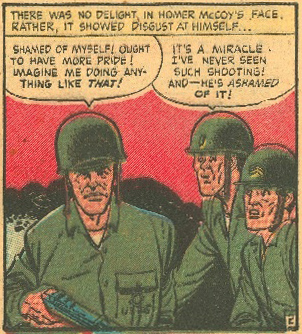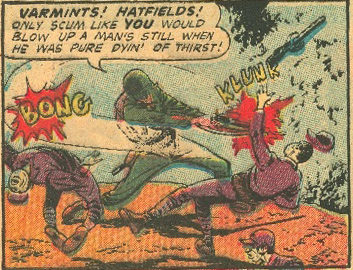
"A’feudin’ and A’fightin’," in The United States Marines No. 8, p. 4. (Government Comics, UNL Libraries)
One of the most dramatic and complex examples of valorization through dangerous aggression was ”A’feudin’ and a’fightin’” in United States Marines No. 8. The comic plays on traditional notions of rugged, unrefined masculinity, as well as both the positive and negative aspects of aggression and defiance of authorities. The comic’s protagonist was Homer McCoy, a mountaineer from the Ozarks who had an anti-authoritarian streak and almost mystical backwoods skills. McCoy’s anti-authority and anti-US government streak stems from his distrust and hatred for the “revenooers,” federal tax collectors, from his moonshining background in the Ozarks.
The story begins with McCoy being called to the front of the battalion, and told to take out a distant machine gunner’s nest.[^] He is able to snipe the enemy installment from an almost impossible distance, but the narrator notes: “There was no delight in Homer McCoy’s face. Rather it showed disgust at himself…”[^] McCoy remarked, “Shamed of myself! Ought to have more pride! Imagine me doing anything like that!”[^]

"A’feudin’ and A’fightin’," in The United States Marines No. 8, p. 4. (Government Comics, UNL Libraries)
According to the narrator, McCoy had “come down” from the hills when he heard there was a war, but he was disappointed when he arrived in Korea to find out this wasn’t a war, but instead a police action.[^] He was excited to fight in a war, but a police action, in his mind, had none of the adventure, honor, and courage of war, and was instead about controlling others.[^] His backwoods masculinity is thus contrasted against the middle class status quo. He was willing to fight in an all-out war for the well-being of the nation, but was unwilling to fight on the side of the police, who sought to constrain the freedoms of individuals.
McCoy continued to do his job for the revenooers, but only when he was ordered. He stayed on his own, and didn’t interact with others in his company, and even built a still and made his own “corn likker,” rather than actively participating in the war.[^] His mindset drastically changes, however, when a grenade destroys his whiskey still. He exclaims, “Them Reds! Now I know who they are - they’re Hatfields! If’n there’s anybody a McCoy hates wors’n the revenooers - it’s them Hatfields all emphasis original”[^] McCoy then “…fell on the Reds with the savage ferocity of a feuding mountaineer…” and charged the enemy, brutally killing two with his bayonet while screaming, “Varmits! Hatfields! Only scum like you would blow up a man’s still when he was pure dyin’ of thirst!”[^] At the end of the story, after McCoy has united with the revenooers against a common enemy, and his rugged skills and extreme tenacity have caused the Reds to retreat, it is revealed that the sergeant threw a red grenade on the still as a ruse to incite McCoy.

"A’feudin’ and A’fightin’," in The United States Marines No. 8, p. 9. (Government Comics, UNL Libraries)
”A’feudin’ and a’fightin’” proves to be more complex than most others in its treatment of masculinity and military culture. McCoy is hypermasculine, but serves as a source of comedy because his masculinity is demonstrated in ways that go against the wishes of the federal government. Prior to the destruction of his still, he practices extreme restraint. It is obvious that he is a talented and deadly soldier, but he does not wish to use these skills unless he must. Once his still is destroyed, however, all restraint is lost, and he savagely attacks the enemy, stopping at nothing to enact revenge against the “Hatfields.”
McCoy is an object of comedic relief in this story, and is not to be taken seriously. Although his skill and eventual courage is admirable, he had a complete misunderstanding of the war, and is easily fooled by his superior. He has the right ideas about honor and restraint, but is seen as incorrect, and made a target of comic relief in his judgement of what the proper line is. His lack of intelligence and role as a foil undermines and dismisses his considerable skill and idealistic masculinity. This also discourages the extremes of masculine aggression he showed – restraint when some aggression was required from the military and aggression that came under false auspices and garnered laughter from his associates and readers.
Related Sections
- Adventurousness & Aggressiveness
- Adventurousness & Aggressiveness - Defend Your Country
- Adventurousness & Aggressiveness - Flight Into Fury
- Adventurousness & Aggressiveness - Li’l Abner Joins the Navy!
- Adventurousness & Aggressiveness - Palau
- Adventurousness & Aggressiveness - Pvt. Droop Has Missed the War!
- Adventurousness & Aggressiveness - Saipan
- Adventurousness & Aggressiveness - Tarawa
- Adventurousness & Aggressiveness - The Fighting Redhead
- Adventurousness & Aggressiveness - Vanguard of Doom
Primary Sources


